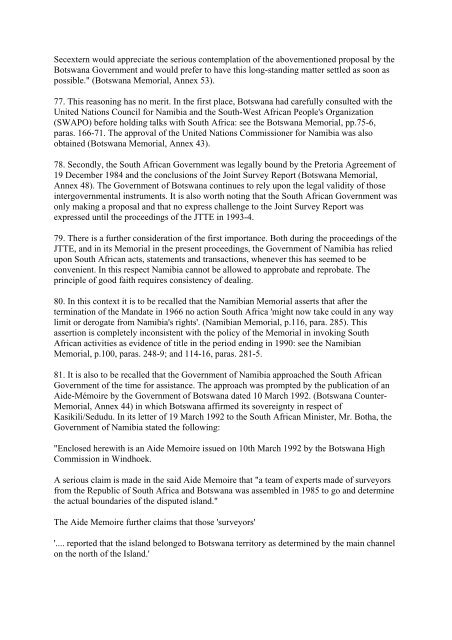botswana/namibia - Cour international de Justice
botswana/namibia - Cour international de Justice
botswana/namibia - Cour international de Justice
Create successful ePaper yourself
Turn your PDF publications into a flip-book with our unique Google optimized e-Paper software.
Secextern would appreciate the serious contemplation of the abovementioned proposal by the<br />
Botswana Government and would prefer to have this long-standing matter settled as soon as<br />
possible." (Botswana Memorial, Annex 53).<br />
77. This reasoning has no merit. In the first place, Botswana had carefully consulted with the<br />
United Nations Council for Namibia and the South-West African People's Organization<br />
(SWAPO) before holding talks with South Africa: see the Botswana Memorial, pp.75-6,<br />
paras. 166-71. The approval of the United Nations Commissioner for Namibia was also<br />
obtained (Botswana Memorial, Annex 43).<br />
78. Secondly, the South African Government was legally bound by the Pretoria Agreement of<br />
19 December 1984 and the conclusions of the Joint Survey Report (Botswana Memorial,<br />
Annex 48). The Government of Botswana continues to rely upon the legal validity of those<br />
intergovernmental instruments. It is also worth noting that the South African Government was<br />
only making a proposal and that no express challenge to the Joint Survey Report was<br />
expressed until the proceedings of the JTTE in 1993-4.<br />
79. There is a further consi<strong>de</strong>ration of the first importance. Both during the proceedings of the<br />
JTTE, and in its Memorial in the present proceedings, the Government of Namibia has relied<br />
upon South African acts, statements and transactions, whenever this has seemed to be<br />
convenient. In this respect Namibia cannot be allowed to approbate and reprobate. The<br />
principle of good faith requires consistency of <strong>de</strong>aling.<br />
80. In this context it is to be recalled that the Namibian Memorial asserts that after the<br />
termination of the Mandate in 1966 no action South Africa 'might now take could in any way<br />
limit or <strong>de</strong>rogate from Namibia's rights'. (Namibian Memorial, p.116, para. 285). This<br />
assertion is completely inconsistent with the policy of the Memorial in invoking South<br />
African activities as evi<strong>de</strong>nce of title in the period ending in 1990: see the Namibian<br />
Memorial, p.100, paras. 248-9; and 114-16, paras. 281-5.<br />
81. It is also to be recalled that the Government of Namibia approached the South African<br />
Government of the time for assistance. The approach was prompted by the publication of an<br />
Ai<strong>de</strong>-Mémoire by the Government of Botswana dated 10 March 1992. (Botswana Counter-<br />
Memorial, Annex 44) in which Botswana affirmed its sovereignty in respect of<br />
Kasikili/Sedudu. In its letter of 19 March 1992 to the South African Minister, Mr. Botha, the<br />
Government of Namibia stated the following:<br />
"Enclosed herewith is an Ai<strong>de</strong> Memoire issued on 10th March 1992 by the Botswana High<br />
Commission in Windhoek.<br />
A serious claim is ma<strong>de</strong> in the said Ai<strong>de</strong> Memoire that "a team of experts ma<strong>de</strong> of surveyors<br />
from the Republic of South Africa and Botswana was assembled in 1985 to go and <strong>de</strong>termine<br />
the actual boundaries of the disputed island."<br />
The Ai<strong>de</strong> Memoire further claims that those 'surveyors'<br />
'.... reported that the island belonged to Botswana territory as <strong>de</strong>termined by the main channel<br />
on the north of the Island.'

















